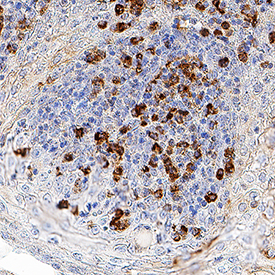Human Siglec-5/Siglec-14 Antibody Summary
Glu17-Thr434
Accession # O15389
Applications
Please Note: Optimal dilutions should be determined by each laboratory for each application. General Protocols are available in the Technical Information section on our website.
Scientific Data
 View Larger
View Larger
Cell Adhesion Mediated by Siglec‑5 and Neutralization by Human Siglec‑5/14 Antibody. Recombinant Human Siglec‑5 Fc Chimera (Catalog # 1072-SL), immobilized onto a microplate, supports the adhesion of human red blood cells in a dose-dependent manner (orange line). Adhesion elicited by Recombinant Human Siglec‑5 Fc Chimera (5 µg/mL) is neutralized (green line) by increasing concentrations of Human Siglec‑5/14 Antigen Affinity-purified Polyclonal Antibody (Catalog # AF1072). The ND50 is typically 0.5-2.0 µg/mL.
 View Larger
View Larger
Detection of Siglec‑5/14 in Human Monocytes by Flow Cytometry. Human whole blood monocytes were stained with Human Siglec-5/14 Antigen Affinity-purified Polyclonal Antibody (Catalog # AF1072, filled histogram) or control antibody (Catalog # AB-108-C, open histogram), followed by Phycoerythrin-conjugated Anti-Goat IgG Secondary Antibody (Catalog # F0107).
 View Larger
View Larger
Siglec‑5/Siglec‑14 in Human Tonsil. Siglec‑5/Siglec‑14 was detected in immersion fixed paraffin-embedded sections of human tonsil tissue using Goat Anti-Human Siglec‑5/Siglec‑14 Antigen Affinity-purified Polyclonal Antibody (Catalog # AF1072) at 5 µg/mL for 1 hour at room temperature followed by incubation with the Anti-Goat IgG VisUCyte™ HRP Polymer Antibody (VC004). Before incubation with the primary antibody, tissue was subjected to heat-induced epitope retrieval using Antigen Retrieval Reagent-Basic (CTS013). Tissue was stained using DAB (brown) and counterstained with hematoxylin (blue). Specific staining was localized to lymphocytes in germinal centers. Staining was performed using our protocol for IHC Staining with VisUCyte HRP Polymer Detection Reagents.
Reconstitution Calculator
Preparation and Storage
- 12 months from date of receipt, -20 to -70 °C as supplied.
- 1 month, 2 to 8 °C under sterile conditions after reconstitution.
- 6 months, -20 to -70 °C under sterile conditions after reconstitution.
Background: Siglec-5/Siglec-14
Siglecs (1) (sialic acid binding Ig-like lectins) are I-type (Ig-type) lectins (2) belonging to the Ig superfamily. They are characterized by an N-terminal Ig-like V-type domain which mediates sialic acid binding (3), followed by varying numbers of Ig-like C2-type domains (1, 4). Eleven human Siglecs have been cloned and characterized (1, 4). They are sialoadhesin/CD169/Siglec-1, CD22/Siglec-2, CD33/Siglec-3, Myelin-Associated Glycoprotein (MAG/Siglec-4a) and the Siglec-5 to 11 (4, 5, 6). To date, no Siglec has been shown to recognized any cell surface ligand other than sialic acids, suggesting that interactions with glycans containing this carbohydrate are important in mediating the biological functions of Siglecs. Siglec-5 to 11 share a high degree of sequence similarity with CD33/Siglec-3 both in their extracellular and intracellular regions. They are collectively referred to as CD33-related Siglecs. One remarkable feature of the CD33-related Siglecs is their differential expression pattern within the hematopoietic system (4, 5). This fact, together with the presence of two conserved immunoreceptor tyrosine-based inhibition motifs (ITIMs) in their cytoplasma tails, suggests that CD33-related Siglecs are involved in the regulation of cellular activation within the immune system.
- Crocker, P.R. et al. (1998) Glycobiology 8:v.
- Powell, L.D. et al. (1995) J. Biol. Chem. 270:14243.
- May, A.R. et al. (1998) Mol. Cell 1998. 1:719.
- Crocker, P.R. and A. Varki (2001) Trends Immunol. 22:337.
- Crocker, P.R. et al. (2001) Immunology 103:137.
- Angata, T. et al. (2002) J. Biol Chem. 277:24466.
Product Datasheets
Citations for Human Siglec-5/Siglec-14 Antibody
R&D Systems personnel manually curate a database that contains references using R&D Systems products. The data collected includes not only links to publications in PubMed, but also provides information about sample types, species, and experimental conditions.
5
Citations: Showing 1 - 5
Filter your results:
Filter by:
-
Decidual glycodelin-A polarizes human monocytes towards a decidual macrophage-like phenotype via siglec-7
Authors: M Vijayan, CL Lee, VHH Wong, X Wang, K Bai, J Wu, H Koistinen, M Seppälä, KF Lee, WSB Yeung, EHY Ng, PCN Chiu
J. Cell. Sci., 2020-07-23;0(0):.
Species: Human
Sample Types: Whole Cells
Applications: Neutralization -
Siglec expression on the surface of human, bull and ram sperm
Authors: K Alkhodair, H Almhanna, J McGetrick, S Gedair, ME Gallagher, B Fernandez-, T Tharmaling, PB Larsen, E Fitzpatric, P Lonergan, ACO Evans, SD Carrington, CJ Reid
Reproduction, 2018-04-01;155(4):361-371.
Species: Bovine, Human, Ovine
Sample Types: Tissue Homogenates, Whole Cells
Applications: IHC, Western Blot -
Soluble Siglec-5 associates to PSGL-1 and displays anti-inflammatory activity
Sci Rep, 2016-11-28;6(0):37953.
Species: Human
Sample Types: Whole Cells
Applications: ICC -
Siglec-9 enhances IL-10 production in macrophages via tyrosine-based motifs.
Authors: Ando M, Tu W, Nishijima K, Iijima S
Biochem. Biophys. Res. Commun., 2008-03-04;369(3):878-83.
Species: Mouse
Sample Types: Whole Cells
-
IL-1F5 mediates anti-inflammatory activity in the brain through induction of IL-4 following interaction with SIGIRR/TIR8.
Authors: Costelloe C, Watson M, Murphy A, McQuillan K, Loscher C, Armstrong ME, Garlanda C, Mantovani A, O'Neill LA, Mills KH, Lynch MA
J. Neurochem., 2008-02-18;105(5):1960-9.
Species: Rat
Sample Types: Whole Cells
Applications: ICC, Neutralization
FAQs
No product specific FAQs exist for this product, however you may
View all Antibody FAQsReviews for Human Siglec-5/Siglec-14 Antibody
There are currently no reviews for this product. Be the first to review Human Siglec-5/Siglec-14 Antibody and earn rewards!
Have you used Human Siglec-5/Siglec-14 Antibody?
Submit a review and receive an Amazon gift card.
$25/€18/£15/$25CAN/¥75 Yuan/¥2500 Yen for a review with an image
$10/€7/£6/$10 CAD/¥70 Yuan/¥1110 Yen for a review without an image

